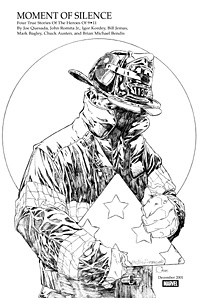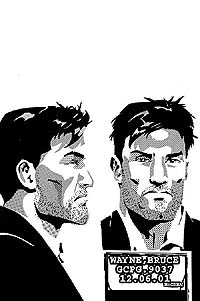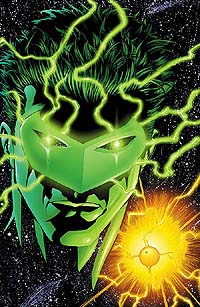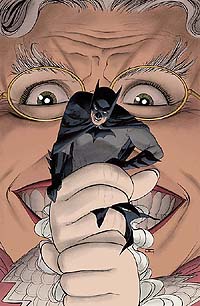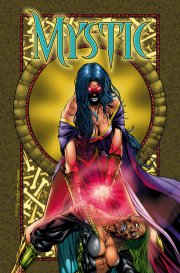|
Each week we take a critical look at some of the best books on the stands, courtesy of Big Guy's Comics (the unofficial comic book store of FanboyPlanet.com). If you publish a book that you want us to be covering, contact us. Or contact Derek. He doesn't have enough to do.
Hey Kids! Comics!
A Moment of Silence
writers and artists: variousLike Amazing Spider-Man #36, this book will prove critic-proof. Unlike that attempt to deal with September 11 in the Marvel Universe, A Moment of Silence is good, both as a fitting reminder of those tragic events and a testament to the potential power of comics as an art form.
Yes, that was the dreaded "a" word. All four very personal stories resonate with appropriate sadness and respect, with varying art styles that capture each moment beautifully. In particular, Scott Morse's delivers a haunting shot of rescue efforts freezing as someone believes they've found a survivor.
Three of the four tales are true, and the fourth, by Kevin Smith and John Romita, Jr., feels true, capturing the mundane turned to chaos. All the stories illustrate how quickly little moments get away from us, and how treasured they should be.
Rating:

The Adventures of Superman #600
A Lex
writer: Joe Casey, artists: Mike Wieringo and Jose Marzan, Jr.A mysterious woman kisses President Luthor at a public appearance, and hours later he disappears. Luckily, Vice President Pete Ross can keep it from becoming public knowledge, and he has a good friend in Superman, a man whose sense of duty overcomes his distaste for the man in the oval office.
Back in Metropolis, a scruffy madman with a bad red toupee has declared war on capitalism, with his most important target being the Lexcorp Towers. While this carries an unfortunate echo with real-life events, the story breezes along too quickly for anyone to take it seriously.
Casey owes a big debt to screenwriter Tom Mankiewicz (uncredited on Superman: The Movie) and indeed, thanks him and Jeph Loeb in the credits. For one all too brief issue, Casey has managed to bring Gene Hackman's characterization to the machiavellian genius who usually lurks under Lex's skin. It works, it's fun, and in the end, we want him to stay.
As a back-up, a few writer/artist teams take a whack at re-imagining the original Superman daily strip. Unfortunately, they each only get to do one daily; DC could have cut the usual art gallery in favor of this more original and entertaining idea.
Overall, this issue makes for a fitting anniversary.
Rating:

The Amazing Spider-Man #37
Interlude
writer: J. Michael Staczynski, artists: John Romita, Jr. and Scott HannaA shocked Aunt May has walked in to Peter's bedroom only to find a badly beaten (and sleeping) nephew and the tattered remains of a spider-costume. Fearing a heart attack, she stumbles back out of his room to encounter discarded webshooters. But with her usual true pluck, the old woman scoops up the costume, puts it in a shopping bag, and leaves to gather her thoughts.
If only Peter had stopped to gather his, he would have noticed that his costume is gone. Otherwise, he might have worried about it.
Instead, as the title of the story suggests, we get cheated out of the ramifications for yet another month. Peter gets involved with helping a troubled student, and JMS does a good job of focusing on this new and intriguing role for Peter. There are some problems that will not be solved by beating up on a bad guy, as Peter himself realizes.
Romita remembers to make Peter look like crap the next day, bandaged and with one cheek consistently swollen from every angle. It's a good touch, and one that superhero comics don't often bother to use. The only question now is why no one in the school administration wonders why their new science teacher shows up for class looking like Edward Norton in Fight Club.
As good as the story is, JMS keeps dropping little details like that and the "stolen" costume. Yes, Peter has a spare, but this is not a man with a lot of money. And he has an identity to keep. He would notice and care. So should the writer.
Rating:

Batgirl
Bruce Wayne: Murderer, Part Two
writer: Kelley Puckett, artists: Damion Scott and Robert CampanellaLabeled the second part of Bruce Wayne: Murderer, this issue really serves more as just another angle on the same story appearing in Detective Comics this week. It opens with Barbara confronting Batman with some hard truths about Batgirl, which will be interesting when she finally has the courage to do it to the man and not a mirror.
While she considers when to actually do this, Barbara picks up the 911 call from Bruce's alleged murder victim. Campanella tends to use heavy blacks, and during this sequence it works better than usual. We cannot see Barbara's eyes, underscoring how helpless and blind she feels as she realizes that the police will consider Bruce a killer.
Calling in the only member of the team she can find, Barbara sends Batgirl to Wayne Manor to do some snooping around. While there, she discovers a shocking secret.
Puckett does a good job of keeping the book's regular subplots moving while still doing his time in a cross-over. While huge chunks can be read elsewhere, there's still enough action dealing directly with the title character to make this a worthwhile buy for fans.
Rating:

Deadman #2
writer: Steve Vance, artists: Josep Beroy and Dan GreenVance answers a question appropriate for the recklessness of Boston Brand. What happens when he gets a host body killed?
As some writers have previously noted, Boston is a young spirit and so prone to experiencing the death again. Thankfully the host does not, even as it passes on. But in three pages Vance highlights a serious character flaw in Deadman: for all his good intentions, he never seems to learn.
But that's okay; he never took life seriously, so death shouldn't be any different. At least now he doesn't get as maudlin as he did in last summer's mini-series. What he does get is immediately involved in his overall task of finding the evil refugees from Nanda Parbat, which is too bad. The first issue looked to have him combating unrelated evil.
Luckily for Boston, the drug trafficking he has discovered involves not one but five of his targets. Vance only gets to develop a couple of them, but if he can focus on the villains' backgrounds, this series might remain interesting.
As it is, it looks like it will get old really fast.
Rating:

Detective Comics #766
Bruce Wayne: Murder, Part One: Procedure
writer: Greg Rucka, artists: Scott McDaniel and Jesse DelperdangThis issue really makes me miss Homicide: Life on the Streets. The bulk of it takes place in "The Box," as detectives try to sweat the truth out of Sasha and Bruce. All evidence points (circumstantially?) to the two having killed Vesper, and their silence only adds to the perception of their guilt.
Since the GCPD cannot know the real reason for their silence, things look bad. We could really use James Gordon right about now.
Rucka has a great handle on the characters. A strange resentment seems to be boiling under Detective Allen, causing him to dismiss any odd clues that might lead away from Bruce's guilt. Paired with Montoya, ambivalent because Bruce had once brought her flowers in Harvey Dent's name, the procedural scenes could have carried an issue by themselves. In fact, they practically do. With Bruce in jail, there's no Batman. Let Rucka turn Detective into a book about ordinary detectives for a while.
Until then, the book is about Bruce Wayne, and McDaniel and Delperdang portray a man seething in cold fury. If any cops should later encounter Batman, they just might put two and two together.
Let's predict now that the hand of Hugo Strange must be behind all this. Even if I'm right, this cross-over has gotten off to a good start that almost makes you forget your resentment at yet another cross-over. Right now, that's no small feat.
Rating:

Fury #5
On Your Guns
writer: Garth Ennis, artists: Darick Robertson and Jimmy PalmiottiIn this book people run around a lot, swear a lot, and get shot up a lot. If you leave out the swearing, this still feels an awful lot like The Punisher.
Granted, in The Punisher Ennis would not kill off so many people he has fooled us into liking, if not caring about. But that only goes to prove that war is hell, and Ennis did a better job pointing that out over at Vertigo.
What we're left with is something just short of satire. It's still over the top (and grittily so thanks to the fine work of Robertson and Palmiotti), but hollow. Ultimately, Fury and Gagarin play an empty game, and both do know that. Ennis made that point in the first issue.
This game-playing has gone on just a little too long, and yet I still want to see how Fury wins it.
Rating:

Green Lantern #146
Hand of God, Day One
writer: Judd Winick, artists: Jamal Igle and Al WilliamsonWinick tips the hand of God with the title, as Kyle has come back from space with more power than a mortal should be allowed to have. All the diffused Oan energy has come back to possess the former Green Lantern (now calling himself Ion), and it's only a matter of time before the diffused attitude of its last owner returns, too.
Though Kyle denies that he's playing God, his actions speak otherwise. Omnipresent? Check - Kyle appears everywhere he senses danger, even when it means that several Kyles battle injustice at once. Omnipotent? Check - The only thing that limits the ring is willpower, and Kyle has no limits right now.
But omniscient, there's the rub. Kyle only thinks he knows everything. Even as he acknowledges that his actions on the war-torn Tendax may be wrong, he still imposes his will. He lies to Jenny for the greater good. And he seems to be ignoring the rules set by the greatest hero of all, Superman: humanity has to fend for itself.
In a way, Winick is recasting Emerald Twilight, but this time he has things like pacing and logic at his command. Ion proves more powerful than Parallax, and we all know what happened there.
Will we get a happier ending this time?
Rating:

Harley Quinn #16
Both Sides Now writer: Karl Kesel, artists: Dodson, Noto, Rousseau, Dodson, and DavisAt last Kesel has brought back the most unique aspect of this series, and lots of it. From Harley's point of view, the world looks an awful lot like an animated series, and it's been months since she has shared that.
The excuse comes as Jimmy Olsen and "Holly" play "He Said, She Said" with Inspector Turpin. On a visit to S.T.A.R. Labs covering a new jet pack (shades of the Ginger announcement - sigh), the two young would-be lovers (He Said) are interrupted by Harley Quinn and Poison Ivy trying to heist the thing.
From Jimmy's point of view, Holly immediately got put in an off-camera deathtrap. Only the timely intervention of Thorn offered any hope. To Holly/Harley, it only makes sense to use the story to talk up how dangerous Thorn is.
Sometimes the loopiness of their crimes makes it easy to forget how lethal Harley and Ivy are supposed to be. The Joker never gets that break. And once Harley figures out that jet pack, things will only get sillier, especially with next issue's guest star on her trail.
It's not quite the bird you think.
Rating:

Batman: Legends of the Dark Knight #151
A Terrible Tragedy
writer: J.M. DeMatteis, artists: Trevor Von Eeden and J.L. Garcia-LopezIn some ways, Mother Grimm is a reflection of Batman himself. Protecting the innocent (in her mind), wearing an outlandish costume and taking a motif way too far. Like Batman, she also somehow managed to build a huge underground high-tech complex without anyone noticing.
And hers has roller coasters, so she's got that going for her.
She also has great psychotropic drugs that reduce Batman to a baby. Though his willpower ultimately triumphs, he remains under the drugs' influence long enough for Grimm to get a glimpse of his psyche. Holy Shades of Hugo Strange!
DeMatteis has created an intriguing villain (and introduces another one near the end), and set the stage. But come on, let's get on with it. This drags a bit, marking time so that this arc can fill five full issues. Robin hems and haws, a few double-crosses get pulled (and probably will again), and the adult Dick Grayson comments that he still feels bad about it.
So bad that we've never heard him tell this story before. And yet his narration still feels like a broken record.
Making up for such flaws is the still great artwork. Von Eeden has been missed, and Garcia-Lopez smooths out some of the pencilers rougher edges. On top of that, John Cassaday does a great cover. Let's see him tackle the bat on some interiors sometime.
Rating:

Mystic #20
writer: Tony Bedard, artists: Brandon Peterson, Joe Weems and Matt Ryan
reviewed by Charlie Wentling.This issue seems to be the climax of the rematch between Giselle and Animora. The outcome is given away on the cover. Or is it? I think Tony Bedard has something less obvious planned.
Giselle spends the whole issue in combat, first with the captured guild masters, then with Animora herself. The action is straightforward, but Brandon Peterson's artwork makes it exciting. This is his last issue, and he goes out on a high note. Peterson deserves a lot of the credit for making Mystic as good as it is.
Hopefully Bedard will continue to move in new directions. The aftermath of this battle should be even more interesting than the battle itself. Giselle would be a more interesting character if her dark side was more prominent.
Rating:

For alternate views and more books, check out Daryl Tay's site, Unique Frequencies.

All comics were reviewed by Derek McCaw unless otherwise noted.













